25 results
Chemistry microsofts in English (UK)
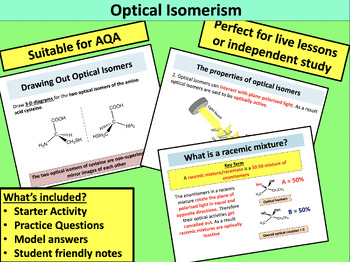
Optical Isomerism
A complete lesson including starter activity, AfL work tasks and main work tasks (all with answers included) on Optical Isomerism. Suitable for AQA A level Chemistry.By the end of this lesson KS5 students should be able to:To know which types of molecules show optical isomerismTo be able to represent enantiomers as 3D molecules showing the chiral centresTo understand why racemic mixtures are optically inactiveDeclaimer: Please refrain from purchasing this popular resource for an interview lesson
Subjects:
Grades:
10th - 12th
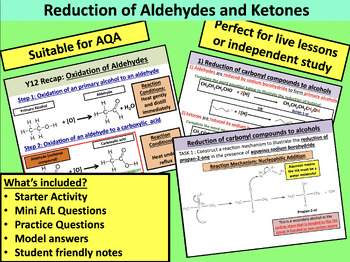
Reduction of Aldehydes and Ketones
A complete lesson including starter activity, AfL work tasks and main work tasks (all with answers included) on the Reduction of Aldehydes and Ketones. Suitable for AQA A level ChemistryBy the end of this lesson KS5 students should be able to:To review the oxidation of alcohols using Cr2O72-/H+ to form aldehydes, ketones and carboxylic acidsTo understand nucleophilic addition reactions of aldehydes and ketones with NaBH4 to form alcoholsTo construct the mechanism for nucleophilic addition reacti
Subjects:
Grades:
10th - 12th

Synthesis of Hydroxynitriles
A complete lesson including starter activity, AfL work tasks and main work tasks (all with answers included) on Synthesis of Hydroxynitriles. Suitable for AQA A level Chemistry.By the end of this lesson KS5 students should be able to:To know how to name hydroxynitrilesTo understand the steps of the nucleophilic addition reaction mechanism to form hydroxynitrilesTo be able to explain how a racemic mixture of hydroxynitriles can be producedDeclaimer: Please refrain from purchasing this popular res
Subjects:
Grades:
10th - 12th
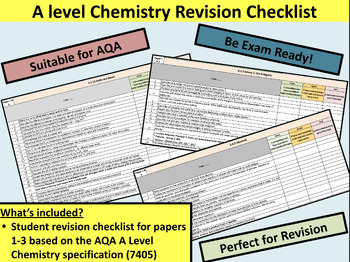
AQA A Level Chemistry Specification Checklist
Student friendly personalised learning checklist for AQA A level Chemistry (7405)This resource includes key specification statements for papers 1-3This resource has ben split into three separate Excel documents for:3.1 physical chemistry3.2 inorganic chemistry3.3 organic chemistryThe exam paper number linked to each topic can be found in the left hand corner of each checklist to aid student exam revision.
Subjects:
Grades:
11th - 12th
Types:
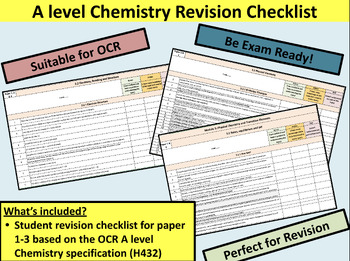
OCR A Level Chemistry Specification Checklist
Student friendly personalised learning checklist for OCR A level Chemistry (H432)This resource includes key specification statements for papers 1-3This resource is one Excel document with tabs for:Module 2: Foundations in ChemistryModule 3: Periodic Table and EnergyModule 4: Core Organic ChemistryModule 5: Physical Chemistry and Transition ElementsModule 6: Organic Chemistry and AnalysisThe exam paper number linked to each topic can be found in the left hand corner of each checklist to aid stude
Subjects:
Grades:
11th - 12th
Types:
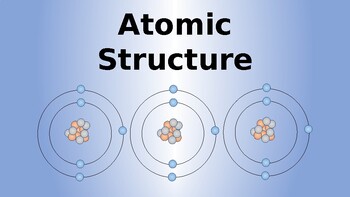
Nuclear Radiation Lesson Pack (11 lessons)
A full set of 11 presentations on the subject of nuclear radiation, tried and tested in the classroom.The following is a list of the lessons included:1. Atomic Structure2. Radioactive Decay3. Background Radiation4. Nuclear Equations5. Radioactive Half-life6. Hazards and Uses of radiation7. Irradiation8. Uses of radiation in Medicine9. Nuclear Fission10. Nuclear Fusion11. Developing the Ideas for the Structure of the Atom
Subjects:
Grades:
6th - 10th
Also included in: Physics Lesson Bundle
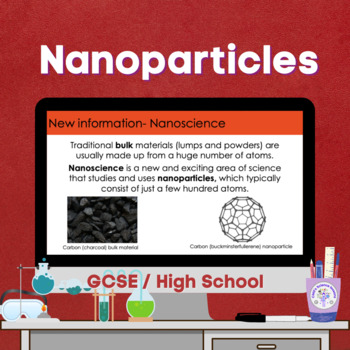
Nanoparticles (GCSE)
During this lesson (nanoparticles) GCSE / High School students work through a variety of activities to develop their understanding of what nanoparticles are and compare their sizes to atoms and molecules. This is the 11th lesson from the GCSE Chemistry C3: Structure and bonding topic. Also available as a digital worksheet, which is ideal for distance learning, independent study or catch-up of missed work through absence. Presentation contains (25 slides)- Bell work activity Lesson objective and
Subjects:
Grades:
9th - 11th
Also included in: C3 Structure and bonding (GCSE)
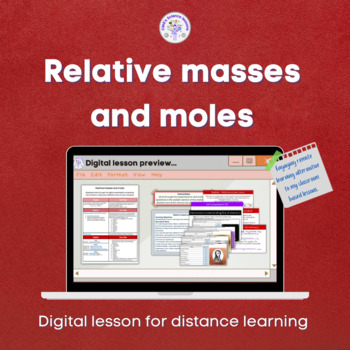
Relative masses and moles Distance learning (GCSE)
This digital worksheet introduces AQA GCSE (High School) students to relative masses and moles. During the lesson students work through the digital worksheet completing a variety of tasks to develop their understanding of how to calculate the relative mass of a compound. Ideal for independent & distance learning / homeschool / covering missed content after absence / non-specialist cover lesson Aimed at a mixed ability class (GCSE / High School) This resource includes:Teacher guidance and ans
Subjects:
Grades:
9th - 12th
Also included in: Relative masses and moles Lesson bundle (GCSE)
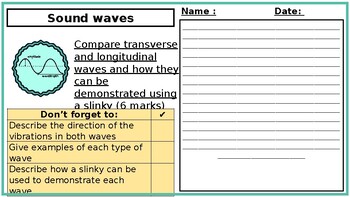
KS3 Science 6 Mark Question with Markscheme - Sound Waves - Physics
Challenging and engaging 6 mark Assessment question for students with a structured mark scheme.Support box on the question sheet to scaffold students.Tailored for year 8 students (7th Grade in US)PPT Editable Document.My students love these, and always try their best to get 6 marks when we do these tasks. I reward them by giving them badges matching the image I designed on the Assessment sheet.These badges will be available on my page.
Subjects:
Grades:
7th

Organic Synthesis , Spectroscopy and Aromaticaly (CHEMISTRY) Note chapter 02
Includes (With mechanisms and examples) perfectThe diels-alder Reaction and RulesEndo and Exo product are formed in the Diels-alder ReactionFormation of Alkenes the writting reactionPhosphorus YlidesFormation of Alkenes- Sulfur YlidesReaction With Cabonuyl Amines and akenesOrganometallic ReagentsPre[aration Of OrganometallicsMetal -hydrogen Exchange (metalation)OrganoLithium CompoundsReactivity of Organolithium CompoundsOrganocuprates(Gilman Reagent)Protecting GroupsBaeyer-Villiger oxidationcal
Subjects:
Grades:
11th - 12th, Higher Education, Adult Education, Staff

Atoms into ions (GCSE)
During this lesson (atoms into ions) GCSE / High School students work through a variety of activities to develop their understanding of how atoms can form positive or negative ions to make compounds. This is the 2nd lesson from the GCSE Chemistry C3: Structure and bonding topic. Also available as a digital worksheet, which is ideal for distance learning, independent study or catch-up of missed work through absence. Presentation contains (25 slides)- Bell work activity Lesson objective and succe
Subjects:
Grades:
9th - 11th
Also included in: C3 Structure and bonding (GCSE)

Relative masses and moles (GCSE)
This lesson presentation introduces AQA GCSE (High School) students to relative masses and moles. During the lesson students complete a variety of tasks to develop an understanding of how to calculate the relative mass of a compound. Also available as a digital worksheet, which is ideal for distance learning, independent study or catch-up of missed work through absence. Presentation contains (28 slides)- Bell work activity Lesson objective and success criteria Information slides Challenge act
Subjects:
Grades:
9th - 12th
Also included in: Relative masses and moles Lesson bundle (GCSE)

KS3 Science 6 Mark Question with Markscheme - Electrolysis
Challenging and engaging 6 mark Assessment question for students with a structured mark scheme.Support box on the question sheet to scaffold students.Tailored for year 8 students (7th Grade in US)PPT Editable Document.My students love these, and always try their best to get 6 marks when we do these tasks. I reward them by giving them badges matching the image I designed on the Assessment sheet.These badges will be available on my page.
Subjects:
Grades:
7th

Structure of the atom (GCSE)
During this lesson (structure of the atom) GCSE / High School students work through a variety of activities to develop their understanding of the structure of an atom and the relative charge and masses of protons, neutrons, and electrons. This is the 6th lesson from the GCSE Chemistry C1: Atomic structure topic. Also available as a digital worksheet, which is ideal for distance learning, independent study or catch-up of missed work through absence. Presentation contains (25 slides)- Bell work a
Subjects:
Grades:
9th - 11th
Also included in: C1 Atomic structure bundle (GCSE)
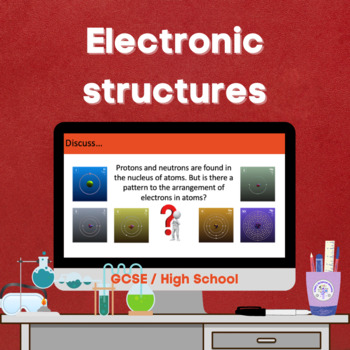
Electronic structures (GCSE)
During this lesson (electronic structures) GCSE / High School students work through a variety of activities to develop their understanding of how electrons are arranged in the first 20 elements. This is the 8th lesson from the GCSE Chemistry C1: Atomic structure topic. Also available as a digital worksheet, which is ideal for distance learning, independent study or catch-up of missed work through absence. Presentation contains (30 slides)- Bell work activity Lesson objective and success criteri
Subjects:
Grades:
9th - 11th
Also included in: C1 Atomic structure bundle (GCSE)

Explaining trends in the Periodic table (GCSE)
During this lesson (explaining trends) GCSE / High School students work through a variety of activities to develop their understanding of the trends in reactivity in Group 1 and Group 7. This is the 5th lesson from the GCSE Chemistry C2: The Periodic table topic. Also available as a digital worksheet, which is ideal for distance learning, independent study or catch-up of missed work through absence. Presentation contains (27 slides)- Bell work activity Lesson objective and success criteria Info
Subjects:
Grades:
9th - 11th
Also included in: C2 The Periodic table (GCSE)

Energy level diagrams (KS3)
During this lesson (energy level diagrams) KS3 / Junior High students work through a variety of activities to develop their understanding of how energy level diagrams represent exothermic and endothermic reactions. This is the 2nd from the 6b Chemical energy topic. Aimed at a mixed ability class (KS3 / Junior High) Presentation contains (19 slides)- Bell work activity Lesson objective and success criteria Information slides Challenge activities (group work)Practical activity (where appropriate)D
Subjects:
Grades:
6th - 8th
Also included in: 6b Types of reactions and chemical energy (KS3)
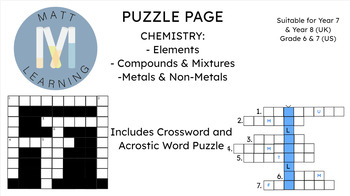
Chemistry - Elements Puzzle Page (Printout)
PRINT OUT version of Chemistry Puzzle page.A Crossword and an Acrostic puzzle covering following Topics:- States of matter- State changes- Solubility- Separation techniques(Answers on page 3 of document)If you would rather have the easel version of this resource for digital distribution on google classroom through easel then please visit my store.Leave a review and follow if you like the resources, Thank you!
Subjects:
Grades:
Not Grade Specific
Types:

Chemistry - States of Matter Puzzle Page (Printout)
PRINT OUT version of Chemistry Puzzle page.A Crossword and an Acrostic puzzle covering following topics:- States of matter- State changes- Solubility- Separation techniques(Answers on page 3 of document)If you would rather have the easel version of this resource for digital distribution on google classroom through easel then please visit my store.Leave a review and follow if you like the resources, Thank you!
Subjects:
Grades:
Not Grade Specific
Types:
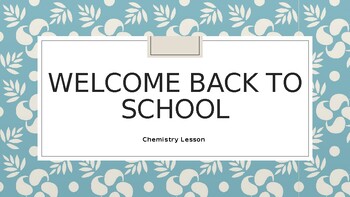
Welcome back to school ( High School)
Engaging introduction to emphasize on importance of communication between teachers and students
Subjects:
Grades:
9th - 12th
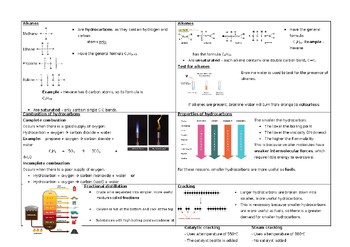
Knowledge Organiser - Organic Chemistry (AQA GCSE Combined Science)
An A3 knowledge organiser on the Organic Chemistry topic from the AQA GCSE Combined Science syllabus.Also suitable for AQA GCSE Chemistry, although does not include the ‘more organic chemistry’ topic.The knowledge organiser includes information on:The structure and formula of alkanesThe structure and formula of alkenesTests for alkenesComplete combustion of hydrocarbonsIncomplete combustion of hydrocarbonsTrends in the properties of hydrocarbonsFractional distillationCracking
Subjects:
Grades:
9th - 11th
Types:

The 4 Areas of Science - Cut and Paste
A simple cut and paste activity where ESL or younger students can look at pictures and sort them into 4 areas of science: chemistry, biology, space, and physics.
Subjects:
Grades:
3rd
Types:
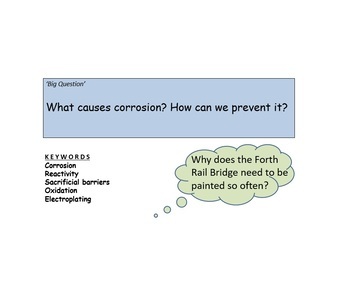
AQA GCSE Chemistry - C15 - Corrosion
A fully resourced package for teaching Lesson 1 of the AQA GCSE topic - Using Resources. This lesson features a powerpoint presentation on Corrosion and its prevention, along with a practical brief for students to design their own practical to test corrosion and the factors which affect it. This is then supported by a differentiated support sheet. There are also a set of practice exam questions related to the lesson content, and the related mark scheme.Please enjoy using this complete lesson fo
Subjects:
Grades:
8th - 12th
Also included in: AQA GCSE Chemistry - C15 - Using Resources complete unit
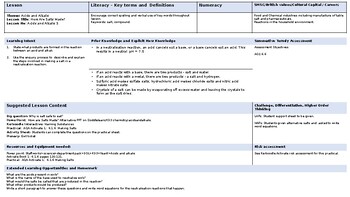
Making Salts (Year 8)
This is a title slide with mini activity onlyIncludes:Title slide with learning intentsMini white board task (7 recall questions from Acid/Alkali topic with answers)Once finished students should complete AQA Activate 1: 6.1.6 Making Salts, which can be found on the kerboodle website.
Subjects:
Grades:
7th
Types:
Showing 1-24 of 25 results





